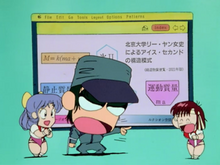Omake

Omake (御負け, often written おまけ) means extra or bonus in Japanese. Its primary meaning is general and widespread; but in America, the term is most often used in a narrow sense by anime fans to describe special features on DVD releases: deleted scenes, interviews with the actors, "the making of" documentary clips, outtakes, amusing bloopers, and so forth. However, this use of the term actually predates the DVD medium by several years. For at least the past 50 years in Japan, omake of small character figurines and toys have been giveaways that come with soft drinks and candy and often the omake is more desired than the product being sold.
In English, the term is often used with this meaning, although it generally only applies to features included with anime, tokusatsu, and occasionally manga. It is thus generally limited to use amongst fans of Japanese pop culture (sometimes called otaku); like many loan words from Japanese, omake is both the singular and plural form.
Omake often include comedy sketches where the characters behave out of character, break the fourth wall, or subtly address opinions of the fandom known to the writers. Sometimes scenes from the TV show or OVA are humorously re-dubbed. One example, included on the Video Girl Ai DVD, replays scenes from the OVA series with new voice-acting in a rural accent. Other times, the same actors voice a new script that is more sexually suggestive, often ludicrously so. Omake can also consist of non-canonical, and often comedic crossover clips that sometimes occur at the end of episodes of two shows airing concurrently from the same studio, such as recent Kamen Rider and Super Sentai programs.
For anime, these are often presented in super deformed style, in the same way manga omake often is. For example, Gunbuster features super deformed characters trying to explain what the writers know to be sheer pseudo-science, or talk about their relationships with each other in a way they do not in the series itself. For live action programs, although not animated, the expressions and sound effects used for comedic purposes can often be inspired by the omake found in the animated mediums.
Another example of an omake in popular culture is related to Squaresoft's Final Fantasy IX. The secret "Blackjack" minigame after completion of the game is accessed by means of a button combination. The Final Fantasy "Playonline" site has a secrets section for Final Fantasy IX, which requires passwords given in the official Piggyback guide to enter. The password needed to reveal the button combination for the Blackjack minigame is E-OMAKE. The minigame itself is, of course, an omake.
Omake occasionally appears in fanfiction about anime or manga, after the story itself, usually as a humorous "alternate ending".
However, in both America and Japan, the anime fandom's use of the word is overshadowed by its everyday meaning of bonus or extra. [citation needed]
Others
- one Omake was shown in Naruto. Lee and naruto are talking about girls then suddenly, Lee reminded Naruto about his first kiss(i.e. with sasuke) then he tries to tell the audiences to turn off the television.
